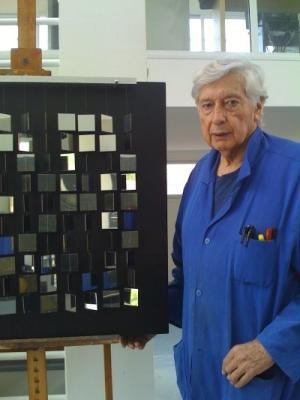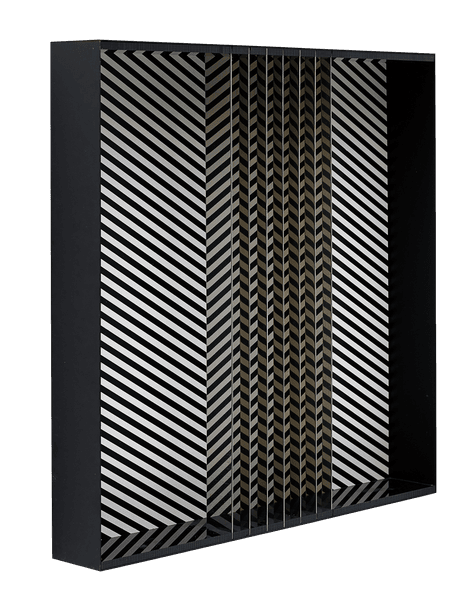Julio Le Parc
Born in Mendoza, Argentina, in 1928, Julio Le Parc studied and engaged with abstract avant-garde movements in Buenos Aires. Whilst at the School of Fine Arts there, and showing growing interest in the artistic avant-garde movement in Argentina he, along with fellow artists Hugo Demarco, F. García Miranda, Francisco Sobrino, Horacio García Rossi, Molnar, began to form what would eventually become the Groupe de Recherche d’Art Visuel, or GRAV.
In 1958, Le Parc moved to Paris, where he connected with artists Victor Vasarely, Jesús Rafael Soto and Carlos Cruz-Diez who were already there. There they met Georges Vantongerloo, François Morellet, and Denise René, a french dealer with whom they became friends. René, a French dealer, was committed to the promotion of abstract art, and later helped launch kineticism. In common, they had studied Lucio Fontana's Spazialismo movement, Le Parc in particular being influenced by the writings of Piet Mondrian and the practice of Constructivism. Upon building relationships with these fellow artists and moving permanently to Paris, the GRAV group was established in 1960 with the collective strategy to delegate the creative act to the viewer. The group advocated for art to play a wider and more active role in society. René published many editions by GRAV artists, with the intention of distributing their ideas faster and more widely.
In 1966, Le Parc won the Grand Prize in Painting at the 33rd Biennale di Venezia. By this time, Le Parc had become engrossed in experiments with light, such as those with projected lights in darkened rooms, adding a sense of playfulness and encouraging viewer participation.
Le Parc was the subject of a solo exhibition at the Metropolitan Museum of Art, Met Breuer, New York 2018-2019
Featured Artists
- Albers Anni
- Ancart Harold
- Andre Carl
- Avery Milton
- Baldessari John
- Barnes Ernie
- Calder Alexander
- Castellani Enrico
- Clough Prunella
- Crawford Brett
- Dadamaino
- de Tollenaere Saskia
- Dyson Julian
- Elsner Slawomir
- Freud Lucian
- Gadsby Eric
- Gander Ryan
- Guston Philip
- Haring Keith
- Hartung Hans
- Hayes David
- Held Al
- Hepworth Barbara
- Hill Anthony
- Hitchens Ivon
- Hockney David
- Hutchinson Norman Douglas
- Jenney Neil
- Katz Alex
- Kentridge William
- Knifer Julije
- Kusama Yayoi
- Le Parc Julio
- Leciejewski Edgar
- Léger Fernand
- Levine Chris
- Marchéllo
- Martin Kenneth
- Mavignier Almir da Silva
- Miller Harland
- Mitchell Joan
- Modé João
- Moore Henry
- Morellet François
- Nadelman Elie
- Nara Yoshitomo
- Nesbitt Lowell Blair
- Nicholson Ben
- O'Donoghue Hughie
- Pasmore Victor
- Perry Grayson
- Picasso Pablo
- Pickstone Sarah
- Prehistoric Objects
- Riley Bridget
- Ruscha Ed
- Sedgley Peter
- Serra Richard
- Shrigley David
- Smith Anj
- Smith Richard
- Soto Jesús Rafael
- Soulages Pierre
- Spencer Stanley
- Taller Popular de Serigrafía
- The Connor Brothers
- Vasarely Victor
- Vaughan Keith
- Whiteread Rachel
- Wood Jonas

